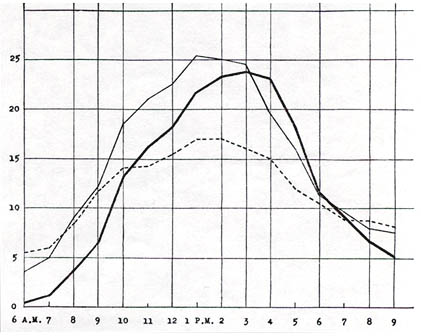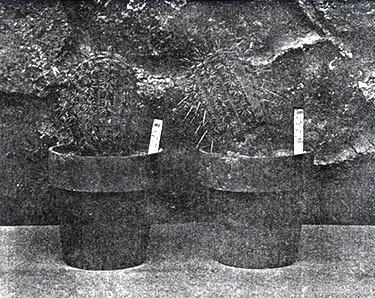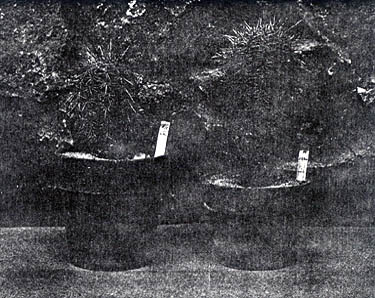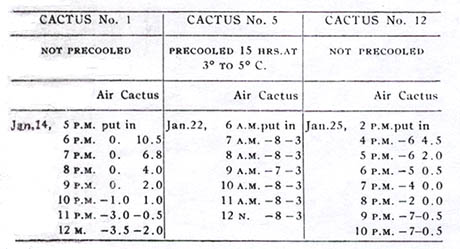
http://people.wku.edu/charles.smith/biogeog/SHRE1911.htm
The Influence of Low Temperatures on the
Distribution of the Giant Cactus
by Forrest Shreve (1911)
Editor Charles H. Smith's Note: Original pagination indicated within double brackets. Notes
grouped at the end. Citation: The Plant World 14 (1911): 136-146.
[[p. 136]] The work
of Müller-Thurgau and of Molisch has shown the variety of ways in
which low temperatures may be fatal to different species of plants. Tropical
forms may be killed by continual exposure to temperatures just above freezing;
other forms survive temperatures slightly below freezing, but succumb
on the formation of ice in their tissues. Certain plants will withstand
the formation of ice in their intercellular spaces at a few degrees below
freezing, but will die at a sudden pronounced lowering of temperature
while they are in a frozen state; at the same time that very many arctic
species will withstand total freezing together with very low temperatures.
In many cases that have been investigated a sudden thawing proves fatal
after a given set of cold conditions, although a gradual raising of temperature
enables them to survive.
The low temperatures of winter have been recognized for a long time, both in scientific and practical work, as important factors in limiting the northward and vertical distribution of tropical and sub-tropical plants. The fact that these plants vary greatly among themselves in resistance to cold, and the fact that it is different phases of winter cold that are fatal to them, is proved by the lack of a coincidence in the northern limit of distribution among any considerable number of them. The line which marks the extreme southern limit of frost is the most important climatic boundary in restricting the northward extension of perennial tropical species, and it is the line along which the influence of winter cold is the simplest in its operation. In the limitation of the sub-tropical species which extend northward of this line a variety of phases of winter cold without doubt are operative. Chief among these are: the greatest number of consecutive hours during which the temperature falls below freezing; the total number of hours of frost in a single winter; the absolute minimum reached and the length of the winter, reckoned from the first frost of autumn to the [[p. 137]] last one of spring. For all sub-tropical plants the greatest number of consecutive hours of frost and the absolute minimum are the most important of these factors, while the others mentioned are more strongly operative further north. In any consideration of the geographical importance of the operation of these factors it is obviously necessary to consider only the conditions of the coldest winters, which serve as a check on the movements made by species during the milder winters.
A consideration of the factors which have to do with the distribution and activities of the Giant Cactus (Carnegiea gigantea,

Fig. 1. Curves showing daily march of internal temperature in Giant Cacti on a cold day. Dotted line: air temperature. Heavy line: temperature of cactus 30 cm. high. Thin line: temperature of cactus 8 cm. high.
Cereus giganteus) led me to believe that the greatest number of consecutive hours of freezing is the most important climatic datum in determining its northward range, and led me to investigate its ability to withstand freezing temperatures, and the character of the winter cold conditions within its range. The Giant Cactus belongs to a group of about 65 species of tropical and sub-tropical arborescent columnar cacti all allied to the genus Cereus. Of this number Carnegia gigantea, Lophocerus schottii and Lemaireocereus thurberi are the only ones [[p. 138]] which extend northward above the limit of frost. The distribution of Carnegiea stretches from the mouth of the Yaqui river, in Sonora, northward along the Gulf of Lower California and the Colorado river to the mouth of the Bill Williams river in Arizona, and eastward to the Santa Rita mountains in southern Arizona, and up the various tributaries of the Gila river to approximately 3900 feet (1190 m.) elevation. The vertical limit of occurrence of Giant Cactus in the desert mountain ranges in the center of its area is 4500 feet (1375 m.), while its abundant occurrence ends rather abruptly at 4200 feet (1280 m.). The distribution of the giant Cactus to the westward of the Colorado river is undoubtedly limited by the low summer rainfall of interior southern California.
In order to ascertain the character of the winter cold conditions within and just outside the range of the Giant Cactus an examination of climatological records was made for the four localities in Arizona at which thermograph records are regularly secured. Yuma, Phoenix and Tucson are within the range of Carnegiea, Flagstaff being considerably above it. The figures in the following table are for the winter of 1909-1910--the most severe for several decades.
STATION YUMA
PHOENIX TUCSON
FLAGSTAFF
Elevation (feet) . . . . . . . . . . . . . . . . . 141
1108
2663
6907
Elevation (meters) . . . . . . . . . . . . . . 43
337
812
2106
Number of days with freezing
temperature . . . . . . . . . . . . . . . . . . . . 13
14
15
193
Number of hours of freezing
temperature . . . . . . . . . . . . . . . . . . . . 32
89
126
2260
Greatest number of consecutive
hours of freezing temperature . . . . . 8
13
19
132
Minimum temperature during
greatest number of hours (Fahr.) . . 25 23
17 -22
Same (Centigr.) . . . . . . . . . . . . . . . . . -4
-5
-8
-30
The most important figures of this table are those which show that the Giant Cactus is capable of withstanding 19 hours of continued freezing temperature and as low a minimum as 17° F. (-8.3° C.). It may be noted that Flagstaff possesses a climate much more rigorous than that of the other stations. The fact that Tucson is only 1300 feet below the limit of the Giant Cactus; while Flagstaff is 3000 feet above it indicates that the cold conditions at Tucson are nearer those which limit the Giant Cactus than are those of Flagstaff.
[[p. 139]] Curves drawn to show the changes of intensity of climatic factors, as followed from one locality to another distant one, commonly show a smooth rise or fall. However, on passing from lower to higher latitudes or altitudes the number of consecutive hours of freezing becomes gradually greater until the point is reached at which days without a mid-day thaw are first encountered; there is then a sudden rise from about 22 hours of frost to from 36 to 42 hours, according as the fall and subsequent

Fig. 2. Young Giant Cacti frozen 42 and 29 hrs., respectively, showing destruction of tissues at base.
rise of temperature are abrupt or gradual. In other words this factor is unique in that the curve expressing its changes of intensity possesses a sudden vertical rise, or indeed a number of such rises. The line along which this takes place in the severest of winters is bound to be an important limit of plant distribution, at least it is so along the line of sudden rise which lies nearest the absolute frost line. It has not been possible to locate this isohoral line exactly from the climatological [[p. 140]] data obtainable for Arizona, but the few figures at hand, when plotted in relation to altitude, and supplemented by the temperature data accumulating from the work of MacDougal and of the writer on the Santa Catalina mountains, show a strong probability that the line lies in the vicinity of the limit of the Carnegiea, which is also the limit of Parkinsonia microphylla, Cercidium torreyanum, Fouquieria splendens, Encelia farinosa, Acacia greggii, Franseria deltoidea, Cassia covesii and a number of other characteristic desert species.
The stout form and high water content of the Giant Cactus suggested the necessity of investigating the relation between the daily curve of its internal temperature and the daily curve for the air, both for the sake of learning whether a given number of hours of freezing air temperature meant as long a subjecting to freezing for the cactus and whether as low a minimum would be reached by the cactus. With this object incubator thermometers were inserted to a depth of 3 cm. in two individuals, 8 cm. and 30 cm. high respectively, and the temperature of the air was read simultaneously. Readings were also made on the north side of an adult cactus at depths of 3 and 7 cm. All the observations made showed a rapid response on the part of the cactus to the changes of air temperature, and all showed a greater amplitude in the daily curve for the cactus than in that for the air, excepting in the case of the deeper thermometer in the adult cactus. The curves shown in fig. 1 exhibit the data secured from the young cacti during a clear day (Feb. 22, 1911) and one of the coldest nights of the winter of 1910-1911. Observations on the same cacti on a completely cloudy day showed a rise of temperature for the larger one almost exactly parallel with the march of the air temperature. Clear days are usually juxtemporaneous with the coldest nights of winter, and under such conditions insolation carries the diurnal temperatures of the cactus above that of the air, while radiation, together with a slight amount of transpiration cooling, carries the nocturnal temperature below that of the air. In other words the surface cells of the cactus are exposed to lower temperature than those indicated by the air thermometer, and the cactus is subjected to a slightly greater number of hours of freezing temperature than is indicated by the air [[p. 141]] thermograph trace. The actual conditions of temperature for a given individual are a function of the amount of heating or precooling it has received during the preceding day.
In order to observe the actual effects of exposures to freezing temperature varying within the limits of duration common to central Arizona, a number of young Giant Cacti were potted, of such size that they could be placed in large freezers. The fact that the Giant Cactus is able to survive for months without renewed supplies of water led me to preserve only the main parts

Fig. 3. Young Giant Cacti frozen 6 and 15 hrs., respectively, showing uninjured condition.
of the root system, and to leave the potted plants without watering previous to their use. Three sets of experiments were made, in which a total of 11 plants of 18 to 28 cm., height were used and pot-grown seedlings less than 1 cm. in height. In each of the three sets of experiments there was one of the larger cacti in which an incubator thermometer was inserted to a depth of 3 cm., with its scale projecting above the lid of the freezer, while there was another thermometer placed to show the air [[p. 142]] temperature surrounding the cactus. In the other experiments of each series only the air temperature was read. The freezing mixture of ice and salt was renewed as required. The several experiments differed in the amount of pre-cooling given, and in the length of time the plants were subjected to an air temperature below freezing. In each case the cacti were allowed to cool gradually by opening the lid of the freezer and allowing the ice to melt during the next 12 hours. This always resulted in surrounding the cacti with air that was cool but not below freezing. After from 12 to 20 hours they were removed from the freezers and placed in a cool room. On the following day they were placed in a green house where the temperature rose to 70° to 80° F. in midday.
Following are given the corrected figures for the temperature of the air (C.) and of the cactus at the outset of the three tests in which thermometers were placed in the tissue of the cactus.

The temperature of cactus No. 1 fell no lower than -4° and it was kept between that temperature and zero for 42 hours. Cactus No. 5 was precooled, and when placed in the freezer was cooled vigorously and taken as low as -11°. It was not allowed to go above -5°, being kept at temperatures below freezing for 29 hours. Cactus No. 12 was taken only to -3° but was kept below freezing for 46 hours. In each case the plant was allowed to stand in the greenhouse for several weeks after [[p. 143]] freezing, alongside unfrozen controls of the same size which had been gathered at the same time and treated in every other respect in the same manner. Within two weeks after freezing all three cacti had begun to show a blackening of their tissues around the base, which through a disturbance of their turgidity lost them their natural erect position. By four weeks after the freezing No. 12 had become black and soft throughout its lower half. Six weeks after the freezing No. 1 and No. 5 were photographed (Fig. 2) so as to show the injured tissues at the base. These individuals were kept for another month and failed to heal or show signs of recovery, at the same time that the controls were still in normal condition.
Seven other young cacti were subjected to freezing temperatures for periods as follows:
No. 4 . . . . . . . . . . . . . . . . . . 9 hrs.
No. 9 . . . . . . . . . . . . . . . . . . 6 hrs.
No. 13 . . . . . . . . . . . . . . . . . 15 hrs.
No. 18 (precooled 2 hrs.) . . . 6 hrs.
No. 19 (precooled 4 hrs.) . . . 6 hrs.
No. 24 . . . . . . . . . . . . . . . . . 14 hrs.
No. 25 . . . . . . . . . . . . . . . . . 14 hrs.
None of these individuals showed signs of injury from frost on being kept for two months in the greenhouse with the others. Two of them, No. 18 and No. 13, are shown in Fig. 3.
Seven seedlings of Giant Cactus one year old were subjected to periods of freezing of from 6 to 42 hours. None of the three subjected to 42 hours survived, but one subjected to 9 hours, and one to 15 hours perished. The fact that the seedlings were hot-house grown, more succulent and less heavily cuticularised than outdoor seedlings probably are1 prevents me from drawing any conclusions as to their being less resistant than the juveniles and adults.
Although the conditions under which these experiments were done were somewhat artificial as respects the coldness of the soil and the high humidity of the air surrounding the plants at the time of exposure to cold, yet I cannot believe that these conditions affect the results materially. The seven experiments in which individuals were subjected to periods of from 6 to 15 hours of frost reduplicated conditions under which the Giant Cactus is placed in nature, and their survival was no more than a confirmation of what might be observed in the [[p. 144]] field at appropriate times. The three experiments in which individuals were given from 29 to 46 hours of freezing reduplicated the conditions to which they would be subjected at higher altitudes and to the northward of their natural range, and they indicate the inability of Carnegiea to withstand such longer durations of cold. I made no examination of the tissues of the cacti which were given the longer durations of frost. It is probable that 20 to 36 hours of frost would kill some individuals and would fail to kill others, and it is only the jump in the controlling climatic factor, to which allusion has been made, that makes the natural operation of this factor decisive and limits the distribution of Carnegiea in an abrupt manner. The occurrence of a single day without mid-day thawing, coupled with a cloudiness that would prevent the internal temperature of the cactus from going above that of the air, would spell the destruction of Carnegiea; and the parallel evidence of the climatological records and of the experiments which have been described appears to explain the limitation of its northward distribution.
The branched arborescent cactus Opuntia versicolor ascends in the desert mountain ranges to 5,800 feet (1,768 m.) and the small form Echinocereus polyacanthus reaches 7,800 feet (2,380 m.), the highest altitude attained by any species of cactus in southern Arizona. Opuntia versicolor is common on the desert mesas and reaches its highest limit only on ridges and southern slopes, while the highest individuals of Echinocereus polyacanthus are found on cliffs and rocks where they are likely to be exposed to insolation and mid-day thawing. Freezing experiments similar to those described were carried out on young individuals of Opuntia versicolor 5 to 25 cm. high and on adults of Echinocereus polyacanthus. The 11 individuals of these species used were given various lengths of exposure up to 66 continuous hours of freezing without any injuries or fatalities. The longest of these exposures is about the length of time that frost would supervene when two consecutive days were without thaw, a condition which must exist in the mountains of Arizona at 7,800 feet altitude in every severe winter. The smaller and more widely distributed types of cacti must all be more resistant to frost than are any of the arborescent columnar or the branched arborescent types. In the Rocky Mountains [[p. 145]] Echinocactus simpsoni is reported to range up to 11,000 feet altitude, while Opuntia missouriensis has been collected by Prof. J. Macoun on the Peace River in Athabasca at lat. 56 deg. 12 min. An indication of the length of greatest exposure to frost for Athabasca can be surmised from the fact that the weather records for Havre, Montana, 250 miles south of the limit of Opuntia missouriensis, show a continuous period of 333 hours (13 days) of frost in the winter of 1909-1910.
In summarising it is necessary to bear in mind that the physical conditions of desert regions are such as to give the daily temperature curve a much greater amplitude than it has in moist regions. At Tucson there are very many days on which the minimum and maximum temperatures are 50° F. (30° C.) apart, and on exceptional days still further than this. The power of insolation to raise the mid-day temperature is so great in all deserts that occupy low latitudes and altitudes, that however cold the nights may be the daily maximum is carried above the frost line. There have, in all probability, been no days at Tucson in many hundreds of years on which the air temperature remained below freezing all day, and the ability of insolation to raise the internal temperature of the Giant Cactus makes it still more certain that none of the individuals of this species now living have endured more than 20 hours of frost, and periods as long as these are due solely to partially cloudy days of the winter rainy season.
The winter temperature conditions of the higher altitudes in the desert mountain ranges are very well indicated by the figures given for Flagstaff, which itself occupies a pass in a range of mountains surrounded by desert. Any attempt to explain the limitation of the bulk of the desert species to altitudes of 4000 to 5000 feet in the desert mountains must take account of the winter cold factors. Between those altitudes the conditions of atmospheric and soil aridity are somewhat less severe than on the desert floor and foot-hills, and between 5000 and 7000 feet these conditions, as indicated by the natural vegetation, are materially less severe. Between 5000 and 7000 feet, however, the vegetation is extremely open, giving abundant opportunity for the invasion of desert species into a region in which the atmospheric and soil moisture conditions are more [[p. 146]] favorable, without by any means being moist. My observation of numerous species of desert plants which have been artificially irrigated or protected from extreme insolation shows that there is no one of them to which a slight amelioration of the atmospheric aridity, or a slight increase of the soil moisture, or of the number of times the soil is made wet, does not permit both a greater vegetative and a greater reproductive activity. These slightly improved conditions are to be found between 5000 and 7000 feet altitude in the desert mountains, but they are to be found only where the winter cold conditions are such that desert species are unable to survive. In other words the failure of desert species to establish themselves in a region which seems at first sight to be a more favorable one than that in which they are common, is due to the operation of a factor entirely distinct from those which have to do with the apparent favorableness.
--The Desert Laboratory, Tucson.
Note Appearing in the Original Work
1. I have never seen any spontaneous seedlings of this size in the field, nor has anyone else, so far as I know. [[on p. 143]]
*
*
*
*
*